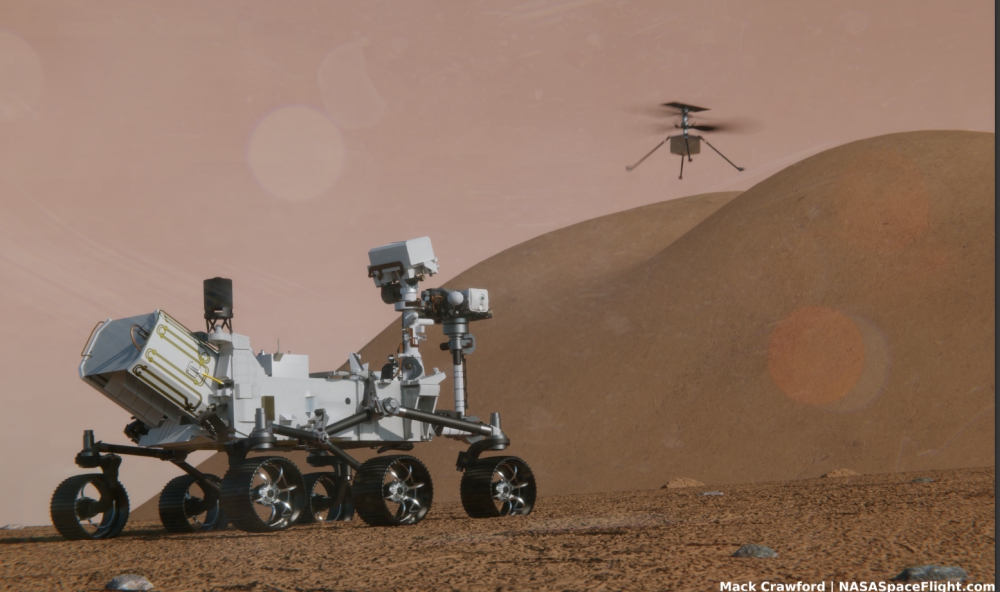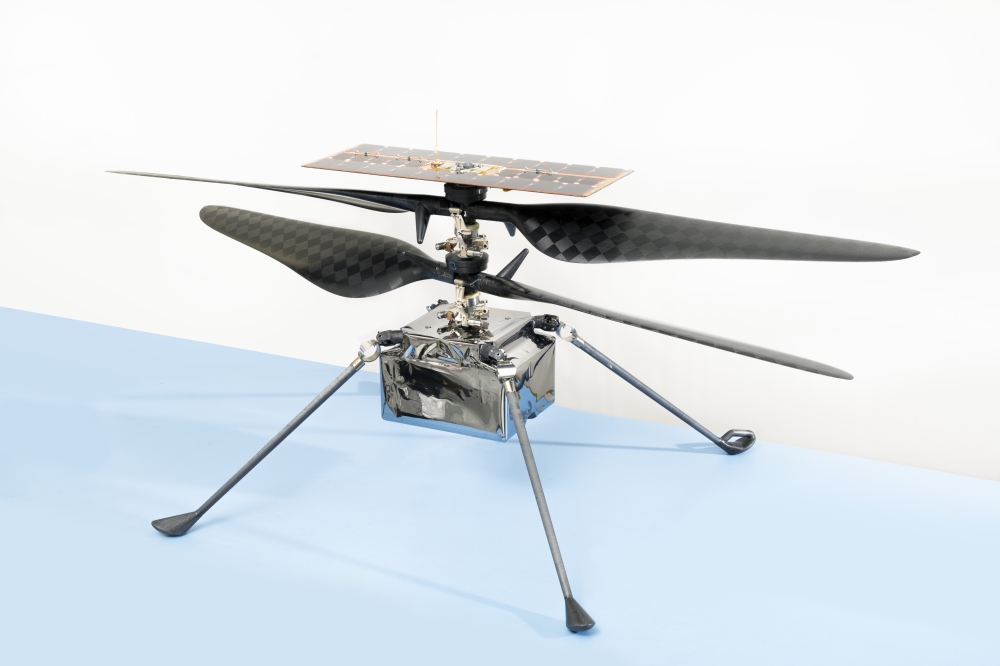As NASA’s newest Mars rover, Perseverance, continues its own checkouts and tests, work is starting for a new phase of the mission – the Ingenuity helicopter. This first-of-its-kind piece of hardware will demonstrate (non-rocket) powered flight on a world other than Earth for the first time. Data from these flights – expected to begin in 30-60 days – will help to develop future programs for missions to Mars and beyond.
Ingenuity is an experimental addition to the Mars 2020 mission. No matter the results of its test campaign, it will not have a significant effect on the primary mission.
Teams are planning for a 30 day flight window for the helicopter. They currently aim for a minimum of one flight, but that has the possibility of being extended. The first flight will feature a relatively simple 20-30 second low altitude hover test before landing. Afterwards, flights will last longer and travel farther.
Ingenuity features a pair of coaxial, 1.2 meter long, carbon fiber rotors. “Coaxial” means that the rotors are stacked on top of each other and spin in opposite directions, dramatically increasing the lift with a minimal increase in area.
The rotors will spin at a rate of 2,400 rotations per minute (RPM) – far higher than the approximately 500 RPM of many Earth-based helicopters. The rotors need to spin fast to account for the extremely thin Martian atmosphere.
The helicopter is powered by a single solar array above the rotors which charges six lithium-ion batteries. These batteries will enable Ingenuity to fly for up to 90 seconds at a time. A single 90 second flight – the maximum flight time of Ingenuity – will consume approximately 8.75 watt-hours – less energy than in an iPhone 12 battery.
Four carbon fiber legs sticking out of the corners of the main body will absorb any extra velocity and shocks upon landing.
The combination of its small size and large amount of composite materials makes Ingenuity especially light, massing 1.8 kilograms. On Earth, this equates to 17.7 Newtons (4.0 pounds), but in Mars‘ lower gravity, Ingenuity weighs only 6.7 Newtons (1.5 pounds).
Once it is deployed from Perseverance, Ingenuity will communicate with Earth through the rover. Each has a small antenna to talk to each other, and the rover will relay data back to Earth using its more powerful communications suite.
Throughout the cruise to Mars, Ingenuity communicated and received power directly through Perseverance. On August 13, 2020, NASA announced that the helicopter was powered on and recharged in space for the first time. This was approximately two weeks after launch. The batteries were only charged to 35%, since each full charge and discharge of lithium-ion batteries slightly reduces their longevity. Keeping them at a low-to-medium charge level minimizes this impact.
Engineers then repeated this test approximately every two weeks during the cruise to Mars.
Perseverance – with Ingenuity attached on its belly – touched down on Mars on February 18, 2021.
The helicopter is currently still connected to Perseverance, as the latter completes its checkouts and initial operations on the Martian surface.
On March 2, the rover successfully deployed and tested its robotic arm. The arm contains several instruments and cameras, most notably the rover’s drill. It also features the PIXL and SHERLOC instruments – containing an x-ray and ultraviolet spectrometer, respectively. These will enable more detailed analysis of surface materials.
Two days later, on March 4, Perseverance completed its first drive across Mars. The 6.5 meter (21.3 feet) trek gave rover operators and mission planners at NASA’s Jet Propulsion Laboratory (JPL) their first opportunity to test out and calibrate the rover’s motors. The short drive consisted of a four meter move forward, a 150 degree left turn, and a final 2.5 meter drive in reverse. The team reported that the rover’s performance was excellent.
They are now beginning the search for a flat and clear area of land – appropriately nicknamed the “helipad” – at which Ingenuity will be deployed. Once Perseverance finds and moves to such a location, the team will command the rover to deploy Ingenuity. This will take place approximately 30 days after landing.
The deployment process consists of several steps to deliver the helicopter to the Martian surface.
First, the cover protecting Ingenuity will be jettisoned, and Perseverance will drive away. Then, the first connections to the helicopter will be cut, and two of its landing legs will be deployed – rotating it away from the belly of the rover. It will then be rotated to a fully upright position under the rover, where its final two legs will be deployed. Perseverance will then drop Ingenuity onto the surface, and drive away to a safe distance.
Ingenuity‘s solo test campaign will begin with a series of internal checkouts, notably testing whether it can maintain a stable temperature and recharge its batteries using its small solar panel.
Should all these steps be completed successfully, the rotors will then be spun up to a high speed, although not fast enough to lift the vehicle off the surface. This will ensure the motors are working nominally and clear the vehicle for flight.
As previously discussed, the initial flight will last 20-30 seconds, and consist of Ingenuity hovering at a small altitude above the surface. Should that flight be a success, later ones will see the helicopter perform more complex operations.
The current test window will last only 30 days, but that is likely to be extended if Ingenuity is performing well.
Ingenuity marks the beginning of otherworldly flight. No matter the outcome, it will provide a trove of data to help the designers of future off-Earth helicopters.
Source: NASA



I think the author got their rotational speeds backward. The last time I look 2400 RPM was slower than 5000 rpm. Niel
Alternately, did they mean 24,000 rpm on Mars? Niel
He said 500 RPM, not 5000
If you are in a vacuum of space or Mars, what air are you going to push?